- Volume 50 | Permalink
Abstract
The Yungang Grottoes Research Academy has been exploring diverse applications of digital technologies for the conservation, research, management, and exhibition of cultural heritage. Since the Digital Yungang Joint Laboratory was established in 2016 by the union of several universities and institutes, many virtual explorations and replication projects using 3D printing have been launched, achieving innovative effects.
The Yungang Grottoes are located in the southern foothills of the Wuzhou Mountains, 17 kilometers west of the city of Datong in Shanxi Province, China. All of the grottoes were excavated in the fifth and sixth centuries along a one-kilometer stretch following the contours of the mountains. Currently 45 grottoes remain, including a total of 252 niches of different sizes and more than 5100 statues. Counted among the most famous ancient grottoes in the world, the Yungang Grottoes have been called one of the four greatest grottoes of China together with the Mogao Caves in Dunhuang, Gansu Province; the Longmen Grottoes in Luoyang, Henan Province; and the Maijishan Grottoes in Tianshui, Gansu Province. The colorful, richly decorated statues in the Yungang Grottoes show magnificent artistry, contributing to the honor accorded to the site as a treasure-house of ancient Chinese sculptural art. Many scholars agree that the works found in the Yungang Grottoes represent the best Chinese sculpture in stone of the fifth and sixth centuries.
Like most immovable cultural heritage sites, the Yungang Grottoes are being eroded by natural forces such as wind, rain, moisture, inorganic salts, and bacteria. The increasing number of tourists also has brought greater challenges for maintaining the balance of the microenvironment in the grottoes. In order to better protect the rich scientific, historical, and artistic values contained in the Yungang Grottoes, digital conservation has become an indispensable part of the cultural heritage conservation work at the site.
The research into and application of digital technologies at Yungang began in 2003 with help from Beijing University of Civil Engineering and Architecture and Datong Reconnaissance Institute of Surveying and Mapping. In recent years, the Yungang Grottoes Research Academy has united several universities and institutes for joint research and exploration projects. A suite of technologies consisting of highly accurate surveying and mapping, 3D laser scanning, geographic information systems, computer networks, and artificial intelligence has been assembled gradually for the documentation of history and the permanent preservation of cultural heritage. The ever-evolving pipeline of digital technology solved the hard problems of the acquisition and storage of information, as well as the display of the large grottoes and elaborate statues in both high and low relief. The applications of digital technologies for the conservation, documentation, exhibition, research, and management of the grottoes have been implemented successfully to great effect.
In order to further improve the level of digital conservation of the cultural heritage at the Yungang Grottoes and to introduce more advanced technological achievements into the work of the Yungang Grottoes Research Academy, in 2016 the Academy invited Zhejiang University, Hangzhou; Wuhan University, Hubei Province; Beijing University of Civil Engineering and Architecture; Beijing Beijianda Technology Company; and Datong Reconnaissance Institute to establish the Digital Yungang Joint Laboratory. The objectives of the Joint Lab include formulating the digital-conservation pipeline for the Yungang Grottoes, encouraging and promoting technology for the digitization of large grottoes, establishing standards for such digitization, and developing the larger data platform for cultural heritage. After years of hard work, certain aspects of the digital conservation work at the grottoes have reached the pinnacle of such efforts in China. These digital conservation efforts complement other physical, on-site conservation work at Yungang and enable more comprehensive documentation, research, and monitoring of the grottoes.
High-Precision 3D Scanning of the Yungang Grottoes
From the perspective of 3D-scanning technology, the Yungang Grottoes are extraordinarily large and complex, and present many challenges. As both completeness and accuracy are essential requirements for 3D documentation, 3D laser scanning technology is the primary technique among many options (fig. 1). Several different brands of 3D scanners, including Leica, FARO, and RIEGL, were used in the digitization of the Yungang Grottoes. The research team also successfully integrated advanced mapping technology with 3D laser scanning to ensure that the 3D digital results of the entire group of grottoes were in the same coordinate system, and to control errors. Considering the massive scale of the site and the large number of grottoes to be digitized, this integration was technologically difficult but crucial for achieving the desired results. After continuous practice and exploration, an integrated technical framework was established, with the surveying and mapping technology building a large-scale surveying control network, the 3D laser scanning technology acquiring a dense 3D point cloud, photogrammetry obtaining high-resolution color textures, and even panoramic photo technology generating web-display assets (fig. 2). Photogrammetry also can effectively supplement the portion of the 3D laser scans that is obscured by the complex shapes of the grottoes, increase the integrity of the 3D model, and add to the smaller details (fig. 3). The initiation of these integrated digitization projects was not based on research needs but on the urgent demand to protect and document the entire site. The results, however, have become invaluable primary sources for archaeological research, virtual exploration, and public education on the Yungang Grottoes.


Archaeological Research Based on 3D Documentation
Based on the high-definition 3D data, the Yungang Grottoes Research Academy has produced an orthophoto of the façade of the whole Yungang Grottoes site. This site elevation provides all of the visual details along with the layout, spatial relationships, exterior shape, and overall image of the grottoes for archaeological research needs (fig. 4). At the same time, the complete 3D model can provide orthophotos for all of the niches and reliefs in the grottoes from multiple points of view, which can be used as a base map for drawing an archaeological line graph (fig. 5).
The orthophotos generated based on the 3D models have distinct advantages over maps drawn by traditional methods of surveying and mapping. Orthophotos not only contain more details but the projection angle and range can be chosen according to the requirements of the application. High-resolution digital orthophotos can be conveniently displayed during the application process. In addition to showing the details of the grotto, such orthophotos also can be used as a base map for creating archaeological line drawings and for mapping the distribution of deterioration in the grottoes.

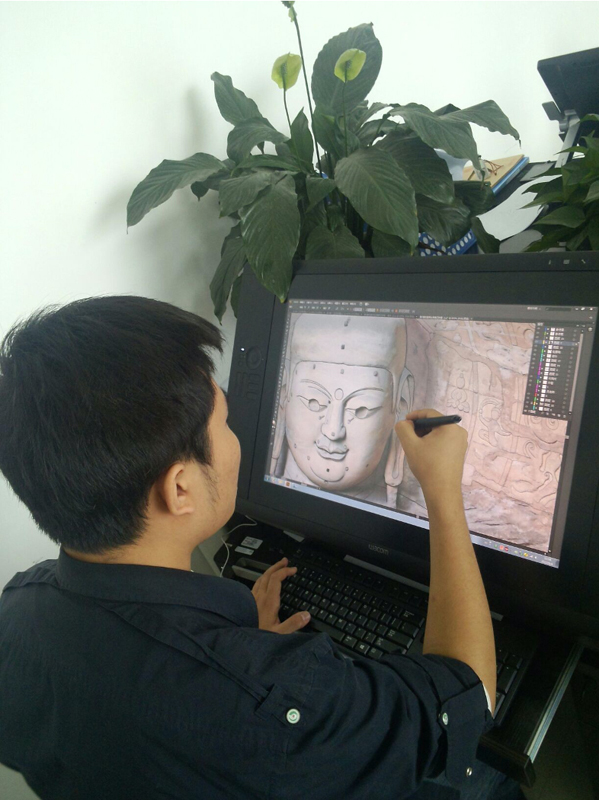
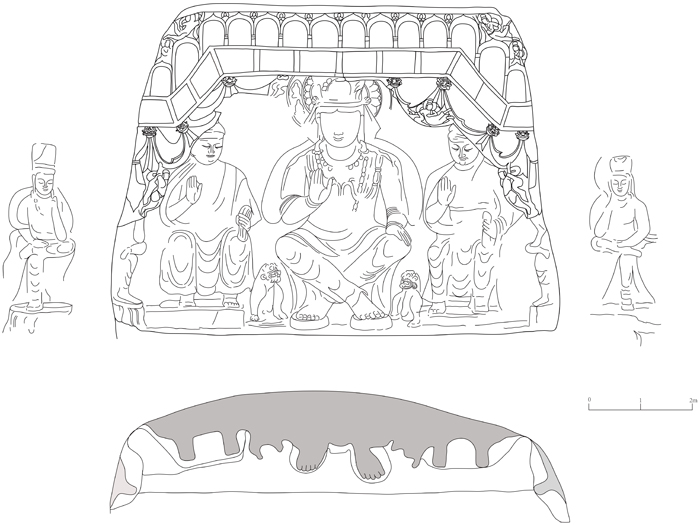
The 3D data also has been used for the virtual restoration of statue fragments from the Yungang Grottoes. During archaeological excavations carried out between 1992 and 1993, many fragments of the collapsed standing Buddha statue on the western side of Grotto 20 were found. The Yungang Academy began a project of stitching the fragments together virtually in 2014 in an attempt to reconstruct the Buddha statue as fully as possible. At the same time, all of the fragments were 3D scanned in high precision, greatly aiding the virtual restoration process (fig. 6).
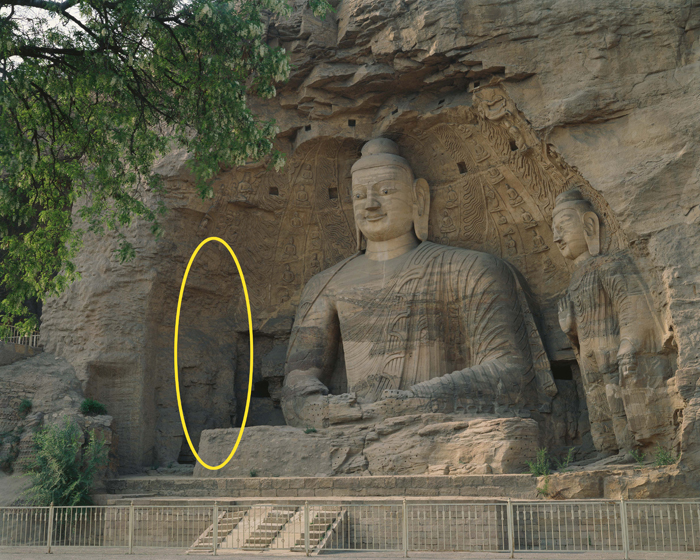
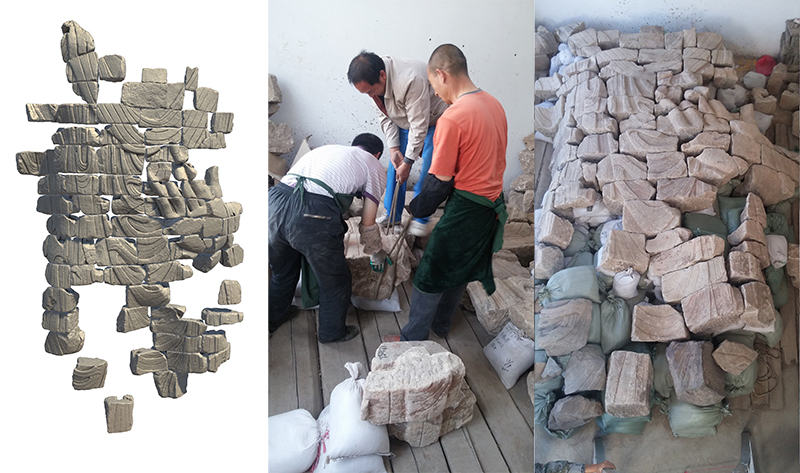
Virtual Exploration Based on 3D Models and Panoramic Photos
The Yungang Grottoes Research Academy has published many panoramic photos on the internet for virtual exploration, including views from outside the grottoes, inside the grottoes, and from the air. These panoramic photos can be used freely on various devices without restrictions on the 3D-rendering performance. The Yungang Grottoes panoramic tour may be accessed publicly worldwide, and supports both VR-browsing mode and normal mode (see https://720yun.com/t/1572dxpuq1n#scene_id=1223016).
Recently, the Academy announced a set of immersive VR explorations of Grotto 18. This technology was implemented in the exhibition Virtual Journeys: Chinese Buddhist Art and Architecture in the Digital Era, held at Stony Brook University’s Charles B. Wang Center in the fall of 2018 (see the article by Jinyoung Jin in this volume). With the help of detailed 3D models, users can experience the Yungang Grottoes by wearing VR headsets. The VR tourism system supports a maximum of fifteen users joining the scene together at a time, and includes a virtual lotus that users may ride to see details high up that are normally beyond range of easy viewing (fig. 7).
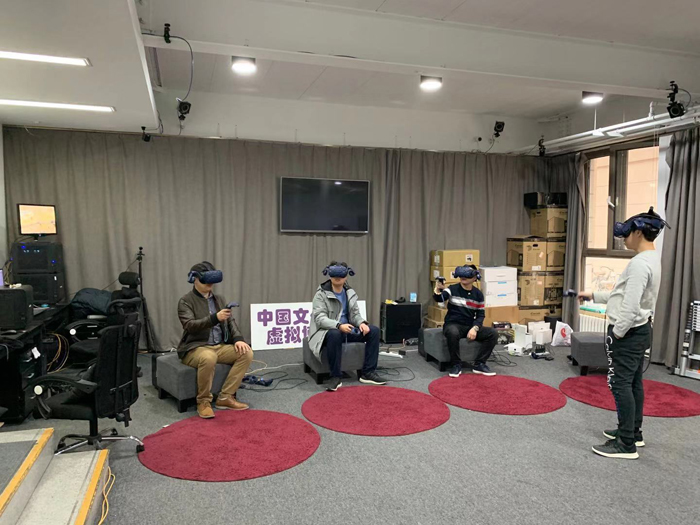
Production of Full-Size Replicas with 3D Printing
In December of 2017, a full-size replica of the rear room of Yungang Grotto 3 officially debuted in the Qingdao City Media Plaza (fig. 8). This replica grotto is intended to give the residents of Qingdao, a city in Shandong Province one thousand kilometers away from Datong, the opportunity to experience the splendor of the Yungang Grottoes. While reproducing the fine art of Yungang in Qingdao, the replica also has been cultivating residents’ interest in the Yungang Grottoes and taking them to visit the site through a reconstruction. At a height of ten meters, the niche of the replica grotto not only captures a magnificent authenticity but represents the first application of 3D-printing technology to a world heritage site of such scale. This project, produced jointly by a team from the Yungang Grottoes Research Academy and Zhejiang University, marks a milestone in the development and usage of digital technology for the preservation of cultural heritage in China. By presenting the massive quantity of digital information on these cultural relics to the audience as a unified whole, the replica grotto gives viewers a deeply immersive experience far beyond the level achievable by current VR headset equipment. The replica grotto is open to all visitors, free of charge, on business days when the building is open. Every day, hundreds of visitors seize the chance to explore the world’s first full-size replica of a Yungang grotto, gaining a great impression of the distant site.
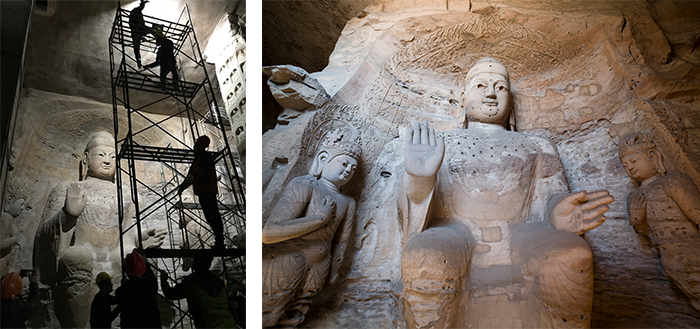
The second full-size grotto replica was built by a joint team from the Yungang Grottoes Research Academy and Beijing University of Civil Engineering and Architecture. The replica of Yungang Grotto 18, at a height of seventeen meters, took two years for the process of 3D printing and assembling. One of the most complex at the Yungang site, the grotto contains many reliefs, complicated ornamentation, and high artistic value. The replication process was quite challenging due to the extreme height, but was completed with incredible success in 2018 (fig. 9). This replica grotto was installed on the campus of Beijing University of Civil Engineering and Architecture, serving as a landmark for the university and providing a powerful sense of art and history to all of the teachers and students there.
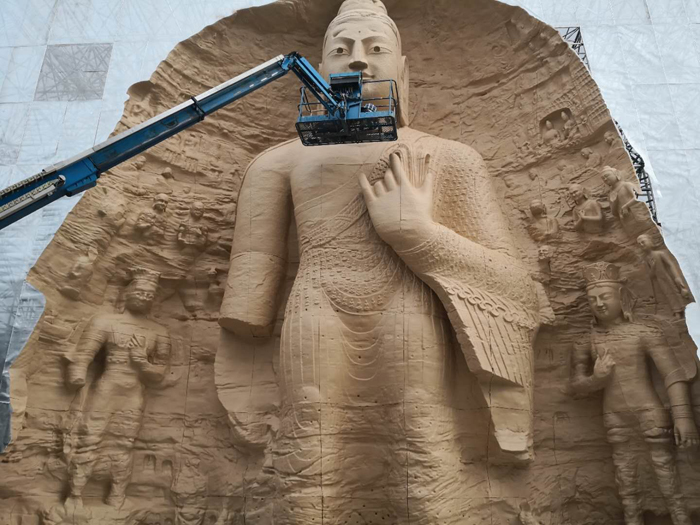
Future Prospects
With the help of progressing 3D technologies, more and more details of 3D shapes and textures can be collected and integrated into massive 3D models. To display large 3D models in real-time VR systems, however, still poses a challenge. In order to avoid the limitations of the current VR rendering capabilities, full-size 3D replicas have been a better choice for the exhibition of the grottoes. Judging from the actual results of these exhibitions, a grotto replica can serve more visitors than a VR system with better immersion. In consideration of effects, diversity, interactivity, economy, and other factors, the Yungang Grottoes Research Academy is constructing a series of digital exhibitions that combine virtual reality and replication technology and planning a worldwide tour.
Appendix: The First Official Published 3D Model of the Yungang Grottoes
Grotto 3, also known as Lingyan Temple, is the largest grotto at Yungang. According to historical literature, Lingyan Temple, which dates from the Northern Wei dynasty (386–535), could accommodate more than three thousand people at a time for Buddhist activities. The original design was a tower of vast scale and unique form, but it was not completed during the dynasty. The northern wall of the grotto is carved with statues of the Buddha Amitābha and bodhisattvas Avalokiteśvara and Mahāsthāmaprāpta, known as the “Three Saints of the West.” The 3D model of Grotto 3 is a result of the combination of 3D laser scanning and photogrammetry, produced by a joint team from the Yungang Grottoes Research Academy and Zhejiang University. The 3D model, which may be browsed and shared for free, has been uploaded to Sketchfab: see https://skfb.ly/6SxrK.
Ars Orientalis Volume 50
Permalink: https://doi.org/10.3998/ars.13441566.0050.007
For more information, read Michigan Publishing's access and usage policy.








